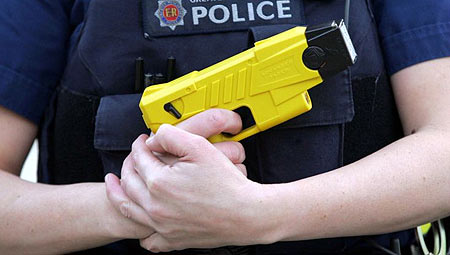Alistair Logan’s recently published article in the Justice Gap Tasers: the ‘non-lethal’ weapon reckoned to have caused more than 500 deaths highlights ongoing concerns with police use of Taser.
- Pics from Flickr, under Creative Comms (Trojan631)
As the national lead for Armed Policing and Less Lethal Weapons, which includes Taser, it may surprise Mr Logan to learn that I agree with much of what he says. Taser is a weapon, it is not risk free and in the wrong hands it is open to abuse. Mr Logan uses the words ‘mission creep’ and he is right to do so; using a Taser to ‘encourage’ someone to comply with a police officer’s instructions is likely to amount to torture, a breach of their Article 3 Human Rights, not to mention a criminal assault.
Where I do take issue with Mr Logan, and some other commentators, is the way in which they conflate Taser use in the US and the UK and their failure to acknowledge the limited alternatives available to police officers facing violence of such severity that the use of a Taser can be justified in law.
Turning first to America, a country with circa 16,000 fully armed separate police forces of varying sizes. As Taser was introduced across the US, it was done so with minimal training. All their officers are firearms trained and Taser was seen as a less lethal alternative for officers who were already well versed in firearms. The weakness of their approach is the lack of overarching national policy, guidance and training and standards are variable. I know from American colleagues that they envy the standardisation we have achieved here in the UK, perhaps this is why Canada are aligning themselves to UK methodology.
So is the headline true, have Tasers really caused 500 deaths in the US? Examination of US cases reveals that they range from where the weapon appears to have been used in circumstances that would breach policy and guidance here, for example the man who falls head first from a first floor roof in New York City after being Tasered, the young woman who falls heavily and head first onto a concrete road after being Tasered as she runs from an officer at the scene of a domestic argument, to the case of 16 year old Robert Mitchell, one of the few cases worldwide that I am aware of where the post mortem report indicates a causal link between the discharge of a Taser and a death. Robert Mitchell was of slight build and was found to have a pre-existing heart condition which caused irregular heartbeats.
Police in the UK have had access to Taser since 2003, its introduction has been cautious and gradual. Some 10 years have passed and around 11% of UK police officers are now Taser trained. Police in the UK adopt the “systems approach” to the introduction of less lethal weapons. This means that the weapon, its components and sighting systems and the training and guidance has to be subjected to scientific and medical evaluation before embarking upon operational trials. This careful approach has provided the Home Office with the confidence to authorise Taser for use by specially trained officers in the UK, something they are highly unlikely to have agreed to if the weapon really has caused 500 deaths in the US.
The systems approach is a strong one and is supported by robust governance and accountability mechanisms to ensure that all use of Taser in this country is recorded and evaluated, and if necessary referred to the IPCC. Our officers receive the best training in the world; a fact recently acknowledged by the London Assembly, but we can not afford to be complacent. Police officers are sometimes required to have the patience of a saint and misuse can occur and mistakes will be made. When this happens they are individually liable in law for the amount of force they use and could find themselves in court and/or facing misconduct proceedings.
Mr Logan is right, since Taser was introduced in the UK there have been 10 deaths following Taser discharge. All but three of these have been fully and independently investigated and in none of them was Taser found to be a contributory factor. These causes include a man who was repeatedly stabbing himself in his stomach, officers Tasered him to stop him from doing so, unfortunately he died from fatal stab wounds and a man who had taken a lethal cocktail of alcohol and controlled drugs and was going berserk, again he was Tasered to get him under control and get him medical help. There are three further cases still under independent investigation by the Independent Police Complaints Commission (IPCC) and we await the outcome of these.
And so to the lack of alternatives. The young men and women of the police service are often the agency of last resort.
If an extremely violent man with mental health issues goes berserk, or a 12 year old girl holds a carving knife to her neck with what appears to be a genuine intention to cut her own throat, who are you going to call?
The police are faced with these types of incidents every day and I have never met an officer who would not try and use their powers of persuasion first, but these kind of incidents can deteriorate very quickly – what would you do? Spectating is not an option for the police. Physical restraint may not be a viable option and remember positional asphyxiation is highly dangerous and can kill. You could try batoning them if you could get close enough, you could try incapacitant spray which is unlikely to be effective, you could even try a dog – imagine the outcry under these circumstances. The bottom line is that the police do not have an option to do nothing and Taser is the only one of the aforementioned options capable of achieving instant neuromuscular incapacitation, it will stop the person from doing what they are doing instantly. In these circumstances it is highly likely to be the safest and least injurious option.
Taser remains an emotive subject, as children we are brought up to fear electricity, not to put our fingers in electrical sockets etc., and the concept of using electricity to subdue a person is an uncomfortable one. A lack of public understanding about Taser is often exploited by the media, some of whom have taken an “anti-Taser” stance. There is a danger that if the gainsayers have their way and Taser is removed from officers as an option then we are back to relying solely on conventional use of force options which rely on pain to achieve compliance. The police deserve to be held to account when we get it wrong, equally front line officers deserve support and recognition as we expect them to put themselves in harms way to protect the public and deal with violent situations. Part of this support is providing them with the best minimum force tools to do the job.
Taser is ‘used’ (use does not necessarily mean fired) over 7000 times per year by police forces in England and Wales. There are a small number of cases where it has been misused and criminal and misconduct cases have resulted, learning has been done and policy and procedure improved. On the other hand there are countless cases where Taser has safely resolved situations where injury or even death may have resulted. Our training is the best in the world and it will remain so because if we abuse it we will lose it. It is all very well to criticise the police for our use of Taser and accountability is paramount, but be careful what you wish for as the alternatives may appear more “acceptable” but they are often more brutal.







